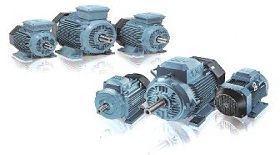Control principle of variable frequency motor
Generally, the control strategy of variable frequency motor is constant torque control at base speed, constant power control above base speed and weak magnetic control in ultra-high speed range.
Base speed: the counter electromotive force is generated when the motor is running, and the size of the counter electromotive force is usually proportional to the speed of rotation. Therefore, when the motor is running at a certain speed, the speed is called the base speed because the magnitude of the counter electromotive force is the same as that of the applied voltage.
Constant torque control: at the base speed, the motor can do the constant torque control. At this point, the counter electromotive force E of the motor is proportional to the speed of the motor. The output power of the motor is directly proportional to the torque and speed of the motor.
Constant power control: when the motor exceeds the base speed, the reverse electromotive force of the motor is kept basically constant by adjusting the exciting current of the motor, so as to improve the motor speed. At this point, the output power of the motor is basically constant, but the torque of the motor is inversely proportional to the speed of the motor.
Weak magnetic control: when the motor speed exceeds a certain value, the excitation current is already quite small and can not be adjusted. At this time, it enters the weak magnetic control stage.



